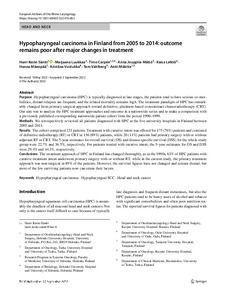Hypopharyngeal carcinoma in Finland from 2005 to 2014 : outcome remains poor after major changes in treatment
Keski-Säntti, Harri; Luukkaa, Marjaana; Carpén, Timo; Jouppila-Mättö, Anna; Lehtiö, Kaisa; Mäenpää, Hanna; Vuolukka, Kristiina; Vahlberg, Tero; Mäkitie, Antti (2022)
Keski-Säntti, Harri
Luukkaa, Marjaana
Carpén, Timo
Jouppila-Mättö, Anna
Lehtiö, Kaisa
Mäenpää, Hanna
Vuolukka, Kristiina
Vahlberg, Tero
Mäkitie, Antti
2022
European Archives of Oto-Rhino-Laryngology
Julkaisun pysyvä osoite on
https://urn.fi/URN:NBN:fi:tuni-202210217728
https://urn.fi/URN:NBN:fi:tuni-202210217728
Kuvaus
Peer reviewed
Tiivistelmä
Purpose: Hypopharyngeal carcinoma (HPC) is typically diagnosed at late stages, the patients tend to have serious co-morbidities, distant relapses are frequent, and the related mortality remains high. The treatment paradigm of HPC has remarkably changed from primary surgical approach toward definitive, platinum-based concomitant chemoradiotherapy (CRT). Our aim was to analyze the HPC treatment approaches and outcome in a nationwide series and to make a comparison with a previously published corresponding nationwide patient cohort from the period 1990–1999. Methods: We retrospectively reviewed all patients diagnosed with HPC at the five university hospitals in Finland between 2005 and 2014. Results: The cohort comprised 231 patients. Treatment with curative intent was offered for 175 (76%) patients and consisted of definitive radiotherapy (RT) or CRT in 156 (89%) patients, while 20 (11%) patients had primary surgery with or without adjuvant RT or CRT. The 5-year estimates for overall survival (OS) and disease specific survival (DSS) for the whole study group were 22.7% and 36.5%, respectively. For patients treated with curative intent, the 5-year estimates for OS and DSS were 29.4% and 44.3%, respectively. Conclusions: The treatment approach of HPC in Finland has changed thoroughly, as in the 1990s, 63% of HPC patients with curative treatment intent underwent primary surgery with or without RT, while in the current study, the primary treatment approach was non-surgical in 89% of the patients. However, the survival figures have not changed and remain dismal, but most of the few surviving patients now can retain their larynx.
Kokoelmat
- TUNICRIS-julkaisut [16951]
